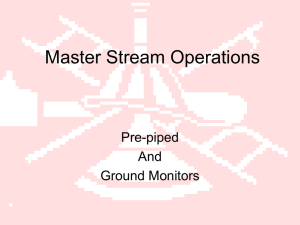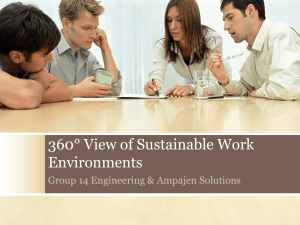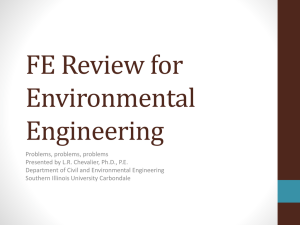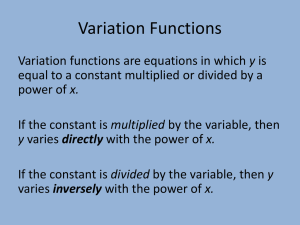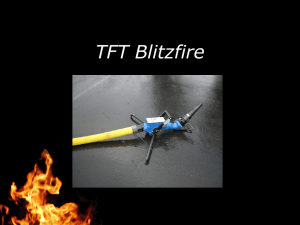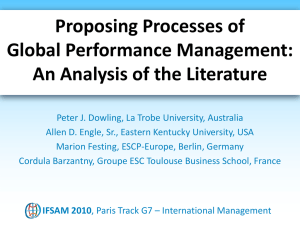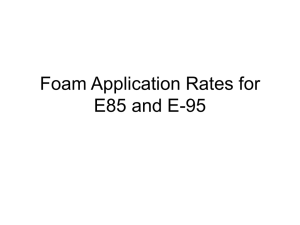Reverse Osmosis (RO) Basics
advertisement
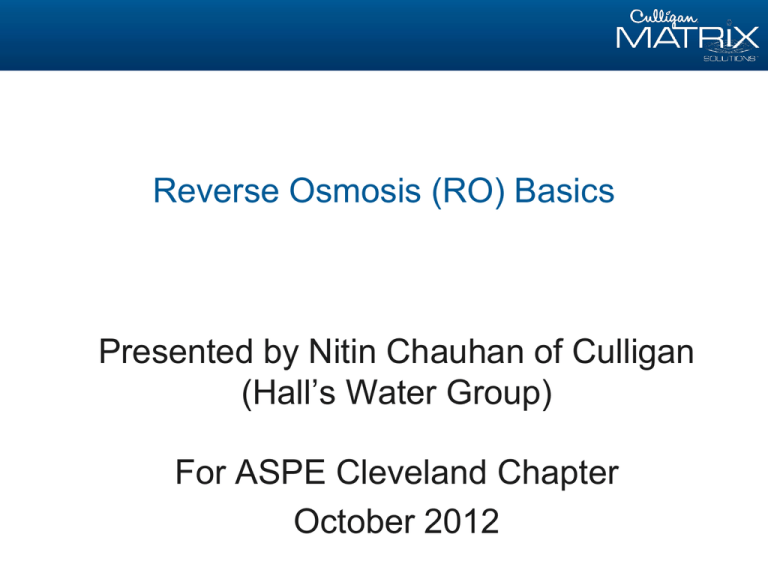
Reverse Osmosis (RO) Basics Presented by Nitin Chauhan of Culligan (Hall’s Water Group) For ASPE Cleveland Chapter October 2012 Outline of Topics I. RO – – – Fundamentals of RO RO Selection and Design Criteria How to size a RO II. Benefits of Using RO – Energy Savings • – – Research from DOE (Dept of Energy) Other Benefits RO for BFW • • • Water Savings Chemical Savings RO Brine Reclaim Outline of Topics Cont’d III. Culligan Background – – – Culligan International Hall’s Water Group Culligan of Greater Cleveland Fundamentals of RO What is Osmosis? The movement of a solvent (water in our case) across a semi-permeable membrane from a solution of lower concentration to a solution of higher concentration that tends to equalize the concentrations of solute on the both sides of the membrane. Osmosis Time Less More Concentrated Concentrated Equilibrium Osmosis in Nature Semipermiable Membrane Osmotic Pressure Brackish Water Fresh Water Osmosis in Nature Pressure Gradient Semipermiable Membrane Osmosis in Nature Semipermiable Membrane Equilibrium Reverse Osmosis Semipermiable Membrane Reverse Osmosis Semipermiable Membrane Reverse Osmosis Semipermiable Membrane Reverse Osmosis Semipermiable Membrane Waste Water Product Water An Osmotic Cell Semi-permeable Membrane Less concentrated solution Seal More concentrated solution Vessel walls Reverse Osmosis Applied Pressure Driving Pressure Osmotic Pressure General RO System Design FOR EXAMPLE, A SINGLE 4” MEMBRANE SYSTEM BY ADDING RECYCLE, THE RECOVERY WILL INCREASE BUT PRODUCT TDS WILL ALSO GO UP 2 GPM 667 PPM RECYCLE 3 GPM 500 PPM 2 GPM 4 GPM RAW FEED FEED CONCENTRATE 667 PPM 5 GPM 566 500PPM PPM PERMEATE 1 GPM 12 10PPM PPM RECOVERY = PERM FLOW x 100 = FEED FLOW 20% 33% REJECTION = ( 1- PERM TDS FEED TDS ) x 100 = 98% General RO System Design ADDING MORE MEMBRANES IN SERIES WILL ALSO INCREASE RECOVERY 7 5 GPM 6 GPM 6 4 GPM 5 GPM FEED 5 4 GPM GPM 4 GPM CONC PERMEATE 1 GPM 1 GPM 1 GPM 2 GPM RECOVERY = PERM FLOW x 100 = FEED FLOW 43 33 20% % % 3 GPM RO Selection and System Design Brackish Water 4” Elements 8” Elements Average 1 GPM Permeate Flow 5 GPM Maximum Feed 16 GPM Flow 64 GPM Minimum Concentrate Flow 20 GPM 4 GPM Pretreatment Water Problems Feed Water Requirements Media Treatment Chemical Treatment Suspend Solids (TSS) NTU < 1 or SDI < 3 (5 max) Depth Filter Inject Coagulants/ Flocculants Chlorine (Oxidizers) 0 ppm Carbon Filter Sodium Meta Bisulfite (SBS) (inject 2 x Cl conc.) Hardness Softened Water Softener Antiscalant (~ 5 ppm) Bacteria 0 counts Ultra Violet Light or Ozone Chlorine Pretreatment Other Problematic Minerals Water Problems Feed Water Requirements Media Treatment Chemical Treatment Iron, Hydrogen Sulfide Fe (2+), 4 ppm Fe (3+), 0.1 ppm Manganese Green 1) Sand 2) 3) Chlorinate Filter Dechlorinate Silica Will precipitate at ~150 ppm NA Special Antiscalant Dispersant. Reduce RO Recovery 1) 2) Factors to Consider When Sizing RO Temperature Pressure Total Dissolved Solids (TDS) R.O. Performance Factors Temperature At lower temperatures, the water is denser, requiring more pressure to ‘push’ it through the membrane Rejection Output R.O. Performance Factors Pressure Higher pressure increases the quality and quantity of product water Rejection Output R.O. Performance Factors TDS Higher TDS (total dissolved solids) raises the natural ‘osmotic’ pressure, which increases the water’s tendency to reverse it’s flow across the membrane Rejection Output Benefits of Using RO Energy Savings-Reference DOE Report Water Savings via increased Boiler cycles of concentration COC (typically increase from 10 to 50 COC. Chemical Savings in the 25 to 50% range. Water reclamation via RO for reject water. Case Study By Department of Energy 26 RO Boiler Savings Typical Boiler PFD Plant Load Condensate Q Steam Rate DA Vent Make Up Steam Loss Sodium Zeolite Softeners Deareator Feedwater Plant Boiler(s) Blowdown Cycles of Concentration - COC 2 cycles of concentration 100 200TDS TDS Calculating % Blowdown FW Cycles = Neutralized Boiler Conductivity __________________________ Feedwater Conductivity % Blowdown = 1 ______________ Feedwater Cycles Dearator/ Feedwater mmhos = 100 ppm Neutralized Boiler mmhos = 3000 ppm X100 = 3.33 % Blowdown Effects of Concentration on Chemical Feed Rate ? Require a 50ppm of residual in the boiler Deareator Feedwater Make Up Plant Boiler(s) Blowdown Boiler Residual / FW Cycles = Feed Rate Feed rate at 10% blowdown or 10 FW cycle = 5 ppm Feed rate at 2% blowdown or 50 FW cycles = 1 ppm Boiler ASME Limits Boiler PSIG TDS max (ppm) 0-300 700-3500 301-450 451-600 601 -750 600-3000 500-2500 200-1000 ALK. max (ppm) 350 300 250 200 TSS Max (ppm) 15 10 8 3 Conductivity (µmho/cm) Silica max (ppm SiO2) 1100-5400 900-4600 800-3800 150 90 40 300-1500 30 Typical Water Analysis Municipal Softened RO Calcium 78 0.5 0.00 Magnesium 33 0.3 0.00 Sodium 50 160.2 1.77 Potassium 3.8 3.8 0.05 Strontium 0.2 0.2 0.00 Chloride 43.6 45 0.47 Sulfate 13.5 13.5 0.09 Bicarbonate 106 106 1.34 Flouride 0.5 0.5 0.00 22.4 22.4 0.29 8 8 6.10 311 320 6.50 Silica pH mmhos in PPM as CaCO3 RO added to Process Flow Diagram Plant Load Condensate Softener Steam Rate DA Vent Reverse Osmosis Q Make Up Steam Loss Deareator RO Reject Feedwater Plant Boiler(s) Storage Tank Blowdown Other Benefits Possible improved steam quality – Lower operating boiler alkalinity – Lower operating boiler TDS Reduction in Neutralizing Amine feed rate – Easier Compliance with FDA steam requirements – Better Condensate corrosion protection Softened RO reject water could be put to use. – – – – Once thru cooling Wash down water, truck rinsing Possible CIP rinses Other non critical apps. Potential Objections RO water is corrosive won’t it hurt my boiler ? The RO water is too pure and is not good for boiler chemistry ? RO’s are not reliable. There is a lot a water loss with an RO. My water treater said I should use a Dealkalizer Case Study: Pet Food Manufacturer All steam directly injected into finished product – 0% Condensate Return – 270 BHP Average Production – 10.7% Blowdown – $1.00/ Therm , $0.04 / KWH – Savings Energy $25,746/ year – Savings Chemicals $12,500/ year Total $38,246/ year – RO System Capital Costs: $38,000/ year Minimum Conditions for Justifications 350 BHP or 12,000 lbs/hr 50% Condensate Return or Less Gas Prices $1.00 per Therm Feed water TDS 350 % Blowdown >7.5% or 13 Feed water Cycles Energy Saving Calculator Boiler Energy Savings.xls Georgia Pacific Case Study 39 RO Brine Reclaim RO Brine Reclaim PFD Brine Reclaim Example Chemical Feed Existing RO Units Inlet Supply Tank 176 GPM Product 132 GPM 44 GPM of Reject Water RO Product Storage New Brine Reclaim Unit Product Reject Storage 22 GPM 22 GPM Reject to Drain 41 Saved 11,500,000 gallons /yr of city water Boiler Blowdown reduced from 25% to 2% Netting: $61,000 per year in energy savings 50% Boiler Chemical savings Boiler Make Up Storage Culligan Background Culligan International Hall’s Water Group Culligan of Greater Cleveland Culligan International Overview US and Worldwide Support and Expertise Over 1400 dealerships around the world - local service and support Largest Pure Water play company Over 600 North American locations Service companies like Coca-cola, Toyota, John Deere, IBM and others 200 U.S. patents 43 Picture this from the 167th floor of the Burge Dubai…….where Culligan works.. Etisalet - RO Monarch – Food service Emirates Towers Shangri La Hotel Dusit – Hotel 44 Index - Service Culligan’s Matrix Solutions Concept Modular Advanced Water Treatment Systems Pre-Treatment Membrane Technology Polish Storage Distribution Control, Instrumentation, Pre-Packaging and Skid Mounting Culligan Matrix Solutions is based on building blocks – – – – – – 45 Large array of applications covered with just a few components Simple, check the box system design concept Each piece pre-engineered to work interchangeably Pick the appropriate size, and all the pieces easily interconnect Great platform to implement our technology & third party’s Maximizes potential to capture spend Industrial Solutions: Capabilities and Resources Process Development & Application Resources (10) • Application/Process Engineers (7) • Chemist & Technicians (3) Services • Bench scale and onsite pilot testing programs • Advanced Filtration: RO, microfiltration, ultrafiltration, nanofiltration Tools • Membrane / IX Resin Projection • Proprietary Process Simulation software • Reliability / Availability Modeling Project Management & Controls Engineering, Design & Procurement Resources (7) • Engineering & Design Managers (2) • Project Engineers / Mech Designers (2) • Electrical & Automation Engineers / Designers (2) • Procurement / Expediting (1) Tools Resources (10) • Project Managers (6) • Planner/Scheduler (1) • Contracts Manager (1) Skill Sets • Senior Project Managers • Proven record of leading large make-up water projects to successful conclusion • AutoCAD 2006, MicroStation v8 • PipeFlo (hydraulic calcs) Tools • Microsoft Project • Electronic Document Control (QAD, Arena) 46 Hall’s Water Group Overview One of the Largest Culligan Dealers in the Franchise Network 29 locations from Coast-to-Coast Over 700 employees 6 locations in Ohio Q&A ???

